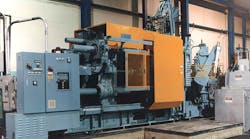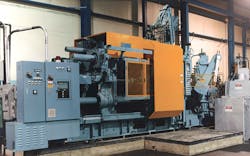An aluminum casting company had been using Houghton Cosmolubric B-220, a vegetable oil-based hydraulic fluid, in one of its machines. The company’s chief engineer reported that seals were leaking, and shafts and bearings were developing a sticky residue. When I hear of a situation like this, I try to get some failed parts for analysis, but in many cases the evidence has been discarded before we can examine it. Luckily, the engineer still had several parts with intact residue. He sent me a bronze bushing that had a coating of shiny black varnish on its inside surface.
Collecting evidence
The first step in finding the cause of the system failure was to analyze the varnish on the bushing. The inside of the part was carefully scraped, and some of the black flakes were collected. FTIR (Fourier Transform Infrared Spectroscopy) is one of our most important analytical tools for identifying chemical compounds, and the infrared spectrum of the varnish showed that it contained a large amount of oxidized phosphate ester. Another important tool is EDXRF (Energy Dispersive X-Ray spectroscopy), which identifies what elements are present in the sample. The X-Ray spectrum showed that the varnish contained 10% phosphorus in addition to particles of iron, copper, zinc, and tin.
A hydraulic system that runs on vegetable oil should certainly not have phosphate ester-based varnish buildup. I requested a sample of fluid out of the system, and when it arrived, we prepared an infrared spectrum. Vegetable oils are composed of glyceride esters, and their infrared spectrum is quite different from phosphate esters. When the two types of ester are mixed together, it’s easy to use the resulting spectrum to calculate how much of each type is in the mixture. The spectrum of our customer’s fluid indicated that the system contained a mixture of 70% Cosmolubric B-220, and 30% phosphate ester based contaminant.
Looking for the source
Our records showed that this customer had purchased phosphate ester fluid for some of their other systems, so we asked them to investigate whether the wrong fluid might have been inadvertently added to the failing system. They found an empty phosphate ester drum, which confirmed that someone had mistakenly added phosphate ester to the system that was supposed to run on vegetable oil-based fluid. Phosphate ester was incompatible with the seals on this particular system, and at such a high level of contamination, it caused the seals to break down and led to the formation of the degraded phosphate ester varnish. The iron, copper, zinc, and tin wear metals were a warning that damage was occurring to moving parts.
The chief engineer reviewed our findings, and he decided that they needed to improve their procedures for making fluid additions to prevent a reoccurrence of the incident. They implemented a new system for better recordkeeping, to make certain that only the specified type of fluid could be added to each hydraulic system.
Robert Johnston is with Houghton International, Valley Forge, Pa. For more information, visit www.houghtonintl.com.


